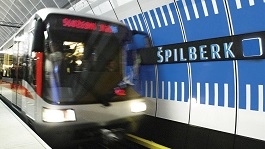
Without an underground railway, Brno cannot do without, stated the councilor
 |
According to Chvátal, not only the north-south connection will be addressed, but also the complete integration with the tram network and the railway transport from Tišnov, Břeclav, and Slavkov u Brna.
The study is expected to be completed in a year and a half and will only hint whether there should be a railway, tram, or metro running under the city. Concurrently, there will be work on two other studies, one dedicated to traffic modeling, and the other to the survey of traffic behavior.
According to planning visions, Brno should have around half a million inhabitants in the future, whereas there are currently approximately 380,000. Among the largest development areas for thousands of residents are Nová Zbrojovka, Špitálka, and the southern center. "There will be an increase in the population and related transportation. This is one of the main reasons for constructing the diameter," said Chvátal. According to Kotzian, the study should respond to what Brno will look like and how populous it will be in 20 to 30 years.
The main north-south direction is, according to Chvátal, dictated by the fact that the intensity of traffic is strongest there. The most residents live in the north, while in the south there is both a train and bus station, which generates a large amount of traffic. "Considering the planned relocation of the railway hub to the river (even further south), the goal is to address the transport connection of this locality to the rest of the city so that it is efficient and above all feasible," Chvátal stated.
According to Kotzian, the study and the proposed underground railway mainly address the problems of people commuting to Brno, but not the residents of Brno themselves. "The city needs a study that will primarily address their needs. And it should solve the crucial improvement of the city's traffic flow with a railway that does not conflict with surface operations, in all directions as needed, even above ground," said Kotzian.
Thanks to the concept of a rapid tram system from the 1970s, Brno has a number of segregated sections, usually from the edge of the broader center to post-war housing estates. According to Kotzian, these sections should be interconnected, making trams faster and allowing them to carry more people. The idea of an underground railway has been considered since the 1970s, but since then Brno has not come closer to construction.
Brno is in a situation similar to Prague after the Second World War, with tram transport being at capacity limits in some places and times. In Prague, the situation was resolved only by the construction of the metro in the 1970s. "Individual car transport is also continually increasing. This cannot be fundamentally accommodated by new routes in the long term, nor is the construction of a large city ring road a complete solution. Therefore, it is important to find an alternative means of transport as soon as possible, which could be the diameter," Chvátal stated.
The English translation is powered by AI tool. Switch to Czech to view the original text source.
1 comment
add comment
Subject
Author
Date
Podzemní dráha
Ing.arch. Josef Myslivec
13.08.20 02:26
show all comments
Related articles
0
27.07.2025 | Brno wants a train underground, it decided based on an analysis
0
01.01.2023 | The study of the Brno underground railway is to be completed by the end of this year
0
02.07.2020 | Brno is looking for a contractor for a study on an underground cable car
0
07.08.2019 | Brno requests a grant for the preparation of a study for the underground railway
0
11.07.2018 | Brno will call an extraordinary council next week due to the station without a subway
0
09.07.2018 | Žít Brno wants to push the government to have the metro with the new train station










